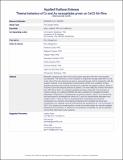Files in this item
Thermal behaviour of Cu and Au nanoparticles grown on CeO2 thin films
Item metadata
| dc.contributor.author | Megginson, Rory | |
| dc.contributor.author | Grillo, Federico | |
| dc.contributor.author | Francis, Stephen M. | |
| dc.contributor.author | Paes, Vagner Z C | |
| dc.contributor.author | Trombini, Henrique | |
| dc.contributor.author | Grande, Pedro L | |
| dc.contributor.author | Rossall, Andrew K | |
| dc.contributor.author | van den Berg, Jakob A | |
| dc.contributor.author | Baddeley, Christopher J. | |
| dc.date.accessioned | 2022-10-27T23:45:58Z | |
| dc.date.available | 2022-10-27T23:45:58Z | |
| dc.date.issued | 2021-10-28 | |
| dc.identifier | 276460733 | |
| dc.identifier | 710af0e1-09d6-4744-9e0c-49dbef35c087 | |
| dc.identifier | 85118508353 | |
| dc.identifier | 000810956800001 | |
| dc.identifier.citation | Megginson , R , Grillo , F , Francis , S M , Paes , V Z C , Trombini , H , Grande , P L , Rossall , A K , van den Berg , J A & Baddeley , C J 2021 , ' Thermal behaviour of Cu and Au nanoparticles grown on CeO 2 thin films ' , Applied Surface Science , vol. In press , 151656 . https://doi.org/10.1016/j.apsusc.2021.151656 | en |
| dc.identifier.issn | 0169-4332 | |
| dc.identifier.other | ORCID: /0000-0001-9961-1212/work/102725189 | |
| dc.identifier.other | ORCID: /0000-0001-9750-6494/work/102725426 | |
| dc.identifier.uri | https://hdl.handle.net/10023/26266 | |
| dc.description | RM and FG acknowledge funding from EPSRC grants (RM: EP/506631/1; FG: EP/M029077/1). JAvdB and AKR acknowledge the EPSRC funding for the use of the MEIS facility at the University of Huddersfield within grant EP/M029077/1. This study was financed in part by the Coordenação de Aperfeiçoamento de Pessoal de Nível Superior -Brasil (CAPES) - Finance Code 001, by Conselho Nacional de Desenvolvimento Científico e Tecnológico (CNPq), and PRONEX-FAPERGS16/2551-0000479-0. | en |
| dc.description.abstract | Bimetallic catalysts are often more active and/or selective than their monometallic counterparts. The behaviour of such catalysts is frequently strongly dependent on the molar ratio of the two elements as well as nanoparticle size and the interaction with the support material. X-ray photoelectron spectroscopy (XPS) is an excellent surface analytical technique for probing the electronic properties of catalytic systems. When a mixture of pure and alloyed particles is present, it is more difficult to extract information from XPS given that it is a spatial averaging technique. Recently, the technique of medium energy ion scattering (MEIS) has been exploited to investigate the depth-dependent composition of nanoparticles on planar surfaces. Herein, we combine the two techniques to investigate the nature of Cu and Au nanoparticles deposited onto ultrathin CeO2 films on Si(111) examining their morphology and chemical composition as a function of annealing temperature for samples that have been maintained in an ultrahigh vacuum environment and exposed to air. The Cu/Au/CeO2/Si(111) is chosen as a model system in order to provide insight into how the catalytic properties of Cu/Au/CeO2 depend on the presence of discrete Cu and Au particles versus fully intermixed Cu/Au systems. | |
| dc.format.extent | 5977809 | |
| dc.language.iso | eng | |
| dc.relation.ispartof | Applied Surface Science | en |
| dc.subject | Alloy | en |
| dc.subject | Catalyst | en |
| dc.subject | XPS | en |
| dc.subject | Ion scattering | en |
| dc.subject | QD Chemistry | en |
| dc.subject | DAS | en |
| dc.subject.lcc | QD | en |
| dc.title | Thermal behaviour of Cu and Au nanoparticles grown on CeO2 thin films | en |
| dc.type | Journal article | en |
| dc.contributor.sponsor | EPSRC | en |
| dc.contributor.institution | University of St Andrews. School of Chemistry | en |
| dc.contributor.institution | University of St Andrews. EaSTCHEM | en |
| dc.identifier.doi | https://doi.org/10.1016/j.apsusc.2021.151656 | |
| dc.description.status | Peer reviewed | en |
| dc.date.embargoedUntil | 2022-10-28 | |
| dc.identifier.grantnumber | EP/M029077/1 | en |
This item appears in the following Collection(s)
Items in the St Andrews Research Repository are protected by copyright, with all rights reserved, unless otherwise indicated.

